Where are André Charlin's original tapes?
When CECE and Disques André Charlin went bankrupt in the early 1980s, a squad of bailiffs came to conduct an inventory, as was normal in such a situation.These people certainly have hidden qualities... but they are sometimes as discreet as a herd of elephants in a China porcelain shop.
During the inventory, "these good people," who didn't know what a magnetic tape was, handled the precious recordings without realizing what they were holding.
And some accidents occur during inventory.
In short, after handling and fiddling with the tapes without sufficient precautions, a number of the original recordings had been destroyed!
The inventory unfortunately sealed the fate of some of the original recordings.
Hopefully, there were, however, survivors.
Among the original tapes from the period that survived the carnage, we found BETULIA LIBERATA on six PYRAL tapes at 76 cm/s, which is perfectly preserved and usable, as well as a recording session with Ernst Erhet of Diabelli's Pastoral Mass, also on PYRAL at 76 cm/s and some other one’s.
The BETULIA LIBERATA tape is a copy for cutting of the original tape dated November 18, 1960.
Alongside these originals, we also found 38 cm/s copies of several scores.
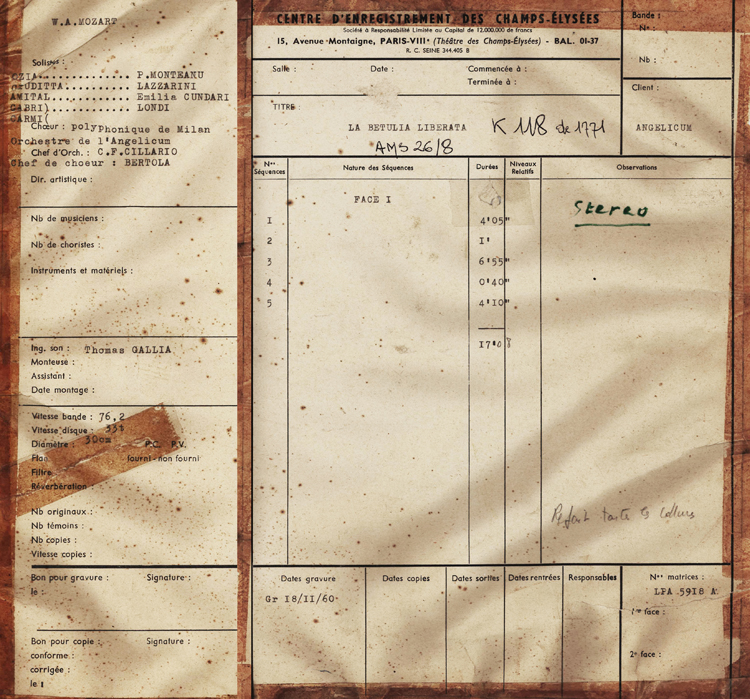
Well, it seemed that a number of original tapes were no longer available.
That wasn't a reason to give up.
I hadn't yet said my last word, so I set about searching for André Charlin's tapes.
Since CECE had traded with various other labels, it was reasonable to hope to find copies of original recordings on NONESUCH, HERITAGE, and others, and of course, on TRIO, which was the representative in Japan.
André Charlin ceased operations in the early 1980s. All CECE recordings and copies were therefore made on robust and reliable pre-1980s tapes.
After the 1980s, during a sad period, magnetic tape became a nightmare!
Since "things were going well," magnetic tape manufacturers decided to play the wizards and released highly unstable chemical formulas that caused untold problems for many studios.
The tape manufacturer, having no satisfactory explanation...
In any case, it's always the customer's fault.
Subsequently, extensive analysis revealed that it was a solvent problem and manufacturers began to replace batches of tapes.
The ALBOHAIRs, through the Charlin donation, had at their disposal the masters metal work for vinyl production, as well as the tapes that survived the "stormy" liquidation inventory.
In the early 1980s, they began to seek out original tapes or copies and contacted the various labels that had business relationships with the CECE.
NONESUCH returned copies made in the mid-1980s, but unfortunately, some of these tapes are only partially usable.
ANGELICUM from his side provided fully usable tapes, including a copy of the VIVALDI / AMS 25 disc.
We still had the "TRIO" copies to exploit.
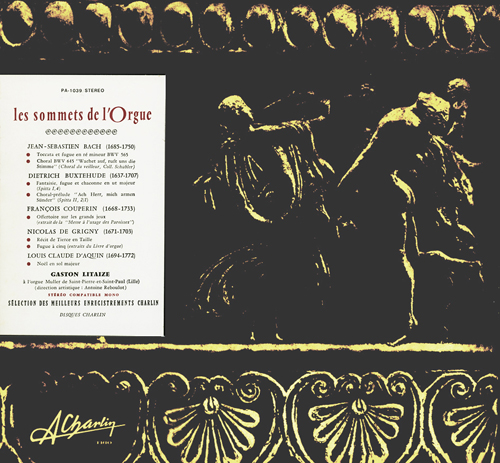
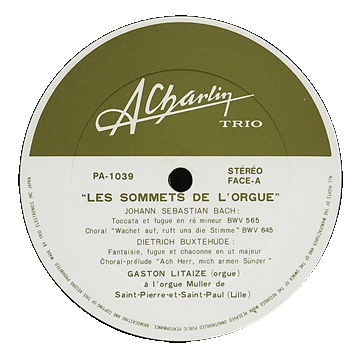
The CHARLIN/TRIO collaboration dates back to the mid-1960s.
TRIO, a respected label in the vinyl era, was primarily focused on jazz, but in 1968, TRIO Records signed a manufacturing agreement with André CHARLIN.
Under this agreement, TRIO executed the cutting and vinyl pressing of a selection of CHARLIN recordings for Japan. CECE sending copies of the original tapes for cutting and pressing in Japan.
Following their request, the ALBOHAIRs obtained from TRIO the return of the 38 cm/s NAB PYRAL copies of the CECE. These TRIO copies of master tapes were used for the production in Japan.
Some of these tapes were accompanied by a TRIO control sheet dated 1982.
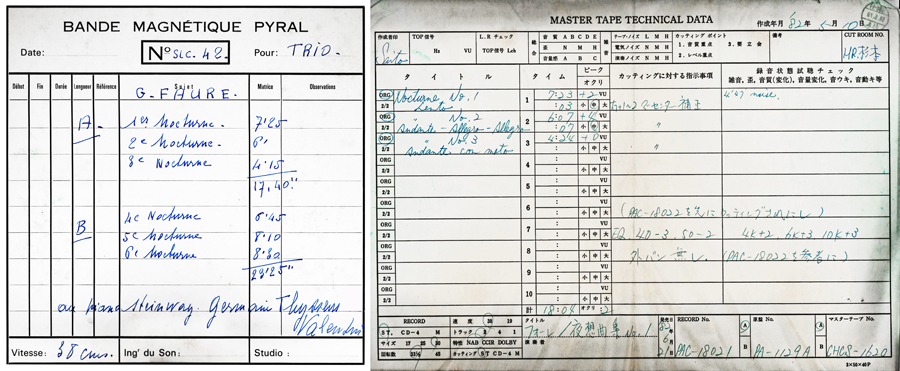
We founded the TRIO tapes for the five FAURE records interpreted by Germaine TYSSENS-VALENTIN.
These FAURE copies were made in 1972, 73, and 76 on PYRAL tape at 38cm/s NAB.
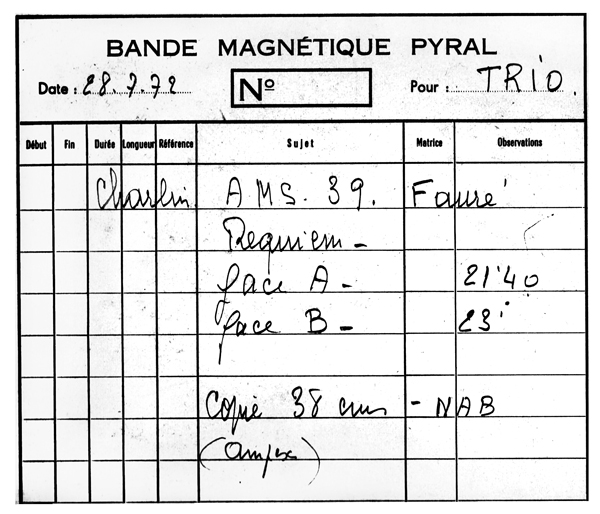
These tapes, recorded on pre-1980 media, are still usable today. I'm not saying there hasn't been any loss of fluxivity, but it's usable.
The original CECE tapes were generally recorded at 76 cm/s.
Backup copies were generally done at 38 cm/s CCIR.
Copies for other labels and foreign representatives were generally done at 38 cm/s CCIR for European market and 38 cm/s NAB for the rest of the world.

More recently, a number of copies have been made using the DOLBY A process, notably Lucio Silla and other Mozart opera.
TRIO also returned to France copies of CECE recordings on SCOTCH 206 made in the mid-1980s, and unfortunately, many of these tapes are "difficult" to use due to the decomposition of the solvents.
This is a known phenomenon. The solution is to evaporate the solvents and dry the tape by placing it in an oven.
Of course, this isn't a kitchen oven! This operation is delicate, but the result is often worth the effort.
As TRIO only returned copies, we can wonder that the original tapes are still in Japan!
What happened after the 1980s?
TRIO, which hadn't seen the CD coming, or hadn't wanted to see it coming, hadn't imagined the post-vinyl era and didn't last long.
In 1985, TRIO separated from its record division and sold it to ART UNION, a company largely formed by former TRIO records members.
After 1985, a first wave of some of Charlin's recordings was released on CD by Crown Records.
Then in 1993, VENUS Records, a company founded in 1992 by Tetsuo Hara, released a 24-CD collection of Charlin recordings. This too is somewhat odd, as VENUS Records, like TRIO, is a label specializing in jazz.
Why having reissue the Charlin collection?
Mr. Hara answers: "I'm a jazz specialist, but I also like classical music."
If there was still a chance to find "original copies" or even "original Charlin tapes", they would have to be found in Tokyo.
ART UNION took over TRIO's entire record department in 1985, including the Charlin records.
In the digital age and due to the reliability issues with magnetic tapes, ART UNION decided to digitize the Charlin recordings.
These digital files would be made available to Mr. Hara when he acquired the rights to the Charlin recordings in 1993. Since Mr. Hara's goal was to release a CD edition, he was not interested in the original analog tapes and did not look further.
In early 2017, I contacted Mr. Hara to discuss the Charlin recordings, and we arranged to meet him at the VENUS Records headquarters in Tokyo. My question about the existence of original tapes piqued his interest, and he quickly jumped at the chance to find the CECE tapes himself.
He contacted a former member of TRIO who was still working at ART UNION, with whom he had worked in 1993. His contact remembered the Charlin recordings very well and unfortunately informed us that the original tapes were destroyed after their digitization.
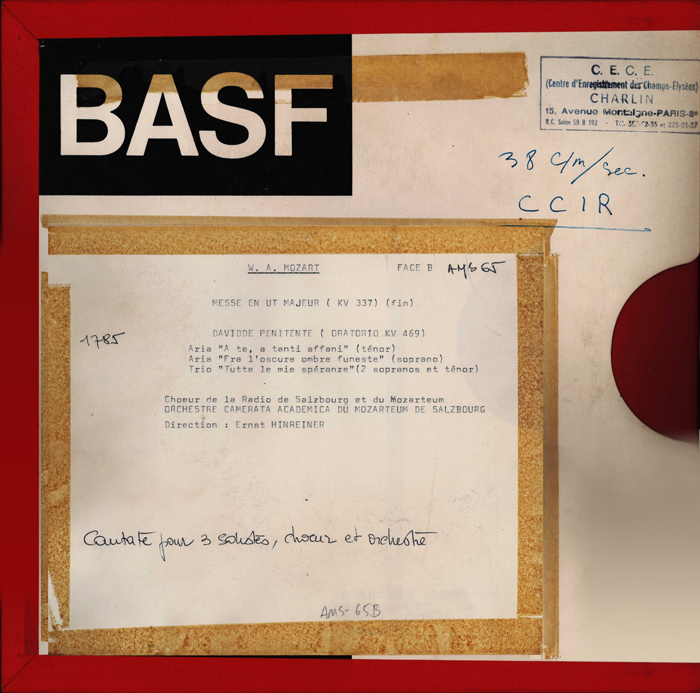
That's the end of the story: there is not a chance left to find original recordings of André Charlin today in Japan.
We must therefore face the facts, and inevitably, we're a little disappointed at first.
But in fact we still have quite a lot of analog original material.
SCOTCH 206 tape returned by TRIO are fragile, and the challenge is to replay them properly.
After drying in an oven, they must be rewound gently without "stressing" them.
I built a rewinding device with a direct path from the supply reel to the take-up reel. The rewind speed is completely controlled to avoid irreversible damage.
For some tapes, we achieve convincing results.
After some trial and error, I managed to "archive" a certain number of recordings.
To archive these precious moments, I used the following equipment, depending on the correction speeds and specifications:
- Playback: NAGRA T AUDIO - STUDER A 812 - SONY MCI APR 5003 - STUDER B 67 MKII.
- Conversion: MADA FORSSELL - certainly one of the best professional mastering converters.
- Recording: NAGRA VI at 24-bit/96 kHz or direct recording to DAW at 24-bit/96 kHz.
- For DOLBY A tapes - Decoding with original tools: DOLBY 360 & DOLBY 361.
(To comply with DOLBY A calibrations, a pair of DOLBY 361s is assigned to the STUDER 812 and a pair of 360s to the NAGRA T Audio.)
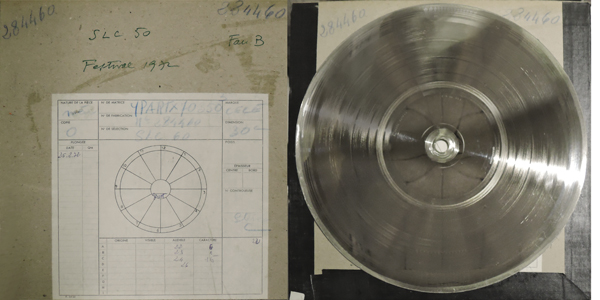
When the first tape recorders arrived on the market in 1948, there was a battle between direct cutting on records and recording on tape.
It was a losing battle because no one ever saw an edit on a record... Have you ever managed to extract a groove and splice it onto another?
Metal works are the ultimate testimony of André Charlin's records, and Arlette Albohair watches over them.
Playing a “mother” metal work under good conditions to obtain usable results is not the easiest task I know.
After taking the usual precautions—because mothers are metal discs, you can't use just any equipment, whether for the turntable or the playback cartridge—we obtain convincing results that still allow us to save these recordings from oblivion.
We have done all this work to bring Charlin's recordings up to date with the release of the new "RENAISSANCE" collection.
For this "RENAISSANCE" collection, only original analog documents were used and handled with the utmost respect to offer high-definition files without artifice nor enhancement.
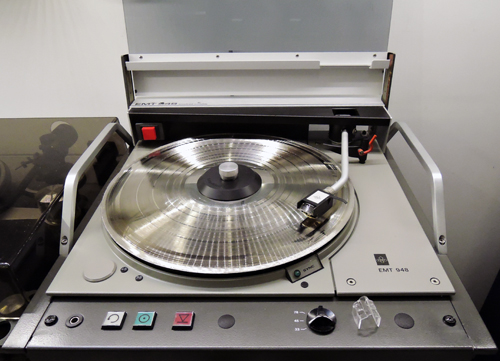
André CHARLIN Disque suite :
A suivre une interview d'André CHARLIN datant des années 80.




